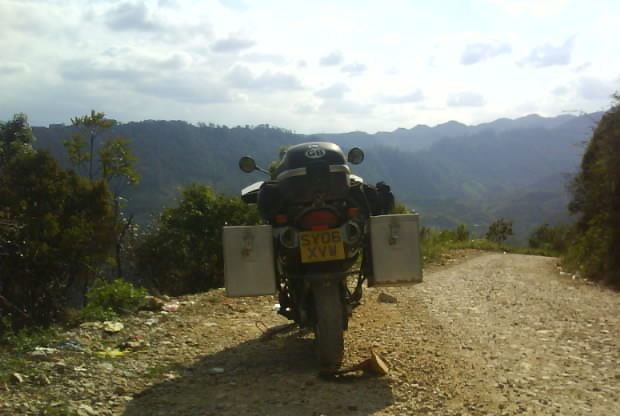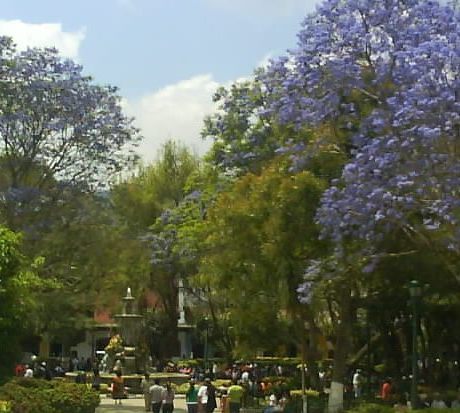Guatemala, Antigua
Heavy rain in Lanquin made the rough dirt road out impassable for me with a fully laden BMW F650GS. Sections of smooth bedrock with a thin covering of mud were difficult to walk on without slipping never mind riding the bike. After finding out that the forecast was predicting rain every day for a week I decided to tackle the dirt road section in the afternoon when it had dried out somewhat and stay in nearby Coban instead of riding to Antigua in one day.

The Road Out Of LanquinAs I was preparing to leave a small off road bike pulled up in front of me. The rider in full biking clothing, full face helmet and all his luggage in a rucksack on his back came over and in a British accent asked if I knew the way to Livingston on the Caribbean coast. I didnt, but got my map out and we plotted the route of probably 120 miles on a number of different roads. He then asked which road out of Lanquin he needed to take to start him off in the right direction. After telling him he rode off without ever removing his helmet. I would have loved to find out more about his trip and how he got to Lanquin without maps or GPS!
Apart from having to ride during the hottest part of the day I didnt have any other problems with the section of dirt track but was still relieved to be back on tarmac going into Coban. It rained the following morning but I donned the wet weather gear and continued to Antigua on tarmac roads. It had been five months since I last rode in the rain when I was in Copper Canyon in northern Mexico so I cant complain.

Antigua 5th Avenue
In Antigua I met up with Frank, a German rider (www.krad-vagabunden.de) I had first bumped into in Mexico and he told me Nick, a British rider (www.talesfromthesaddle.com) we had both met previously was camping in the tourist police compound. I was in a hostel waiting to receive a new bank card and credit cards from England and once these arrived moved into the campground with Nick. Camping in the Tourist Police Compound is free and must be one of the most secure places to stay in Guatemala with lots of heavily armed police coming and going all day long.

Tourist Police Compound Campsite In Shade of Earthquake Damaged Building
Nick was having problems with his Yamaha 125cc YBR engine and although my motorcycle mechanics skills are a bit rusty offered to help and give moral support to trace and rectify the problem. Stripping the engine as far as separating the crankcase without any of the special tools available in a proper workshop proved a challenge which we eventually overcame with a process of trial and error. With much waiting for parts, devising or borrowing special tools, drinking coffee and eating cake Nicks bike was eventually running again.

Me Playing At Motorcycle Mechanics
The Yamaha dealer in Guatemala City had offered to supply all the required spares for free in exchange for Nick doing a TV interview in the showroom and with his new found celebrity status Nick graciously allowed me to chauffeur him for his TV appearance on my bike. To add to the drama of the day on the way into the city we passed a prison where we later learnt there had been a gunfight two hours earlier as friends of some prisoners attempted to free them as they were being transferred to court.

TV Celebrity Nick At Yamaha Canella, Guatemala City
On the return journey my bikes front sprocket nut came off, wrapped itself around the chain and broke a tooth on the front sprocket. I managed to ride gently back to Antigua but then we had both bikes disabled. Raul, the owner of the Yamaha dealership in Guatemala City had given us tickets to watch his son racing in a motorcycle road race which would have been the first motor racing of any kind I would have seen since starting this trip two years ago so I was really looking forward to the weekend but with two dead bikes we didnt have any transport and couldnt go. I have been singing the praises of the mechanic in Mexico that fitted my new chain and sprockets 2000 miles ago. The front sprocket nut is supposed to be torqued and secured with loctite and a tab washer so shouldnt work loose if fitted correctly. A friend, Julio was taking his BMW to the Guatemala City dealer to get some warranty work done and picked up my parts while he was there saving me from having to get the bus into the city.

Antigua Park
Antigua is nestled between three volcanoes. The most prominent viewed from the city is the Volcan de Agua (Volcano of Water) which got its name after destroying the original capital city by burying it during a mudslide in 1541. Antigua was rebuilt on a new site further north. Acatenango volcano last erupted in 1972 with volcanic ash falling up to 25km away. The Volcán de Fuego (Volcano of Fire) has erupted frequently since the Spanish conquest and is almost constantly active at a low level. When the top isnt concealed in cloud smoke can regularly be seen during the day and a red glow emits from the summit at night. The last eruption in 2007 caused seven families to be evacuated.

Agua Volcano Towering Over Antigua
Many of Antiguas colonial buildings were destroyed in major earthquakes in 1717 and 1773 prompting the creation of the current capital Guatemala City. Many of the old walls from the ruined buildings remain. Antigua continues to be affected by earthquakes and tremors, there was a minor tremor early one morning while I was camping in the shade of one of the ruined buildings making me question my choice of campsite but fortunately the wall remained standing. In 1976 Antigua buildings were damaged in a major earthquake that killed 23,000 Guatemalans and left a million people throughout the nation homeless.

Creating a 'Carpet' From Coloured Sawdust
Antigua is famous for its Lent and Holy Week Festival. Processions take place to different churches, starting with one procession each Sunday at the beginning of Lent and building up to several a day by Easter weekend with each procession getting bigger and more elaborate as Easter approaches. Elaborate carpets are created using coloured sawdust, flowers, leaves etc. on the cobbled streets forming the procession route. The carpets can take up to twelve hours to make and are destroyed in seconds when the procession walks through them. There was a procession at 4am on Good Friday, a bit early for me but I was told that all the carpets were washed away in heavy rain before the procession arrived.

Children Struggling With Their Float During A Procession
Religious icons are carried on floats weighing up to 3.125 tonnes on the shoulders of bearers in relays. The larger floats have eighty bearers at a time swaying from side to side as they all march in step. The childrens procession was my favourite. While the adult bearers were very stoic and didnt display any emotion the children were grimacing as they struggled with the weight.

The Smaller Children Get Involved with Suitably Scaled Down Floats
On a day trip to Atitlan Lake I had to ride through my first river on this trip following the collapse of the bridge. I couldnt see the bottom and might have decided to wade through first but I had been assured by Nick who had already ridden the route that the bottom was smooth so rode straight through with my feet lifted up and got to the other side without getting wet.
While I was having a picnic lunch at a viewpoint (Mirador) over looking the lake an English cyclist turned up. He had been on an Alaska to Ushuaia motorcycle trip several years ago and liked Lake Atitlan so much when he arrived that he bought a house, moved in and never completed his trip.

Lake Atitlan
As the crowds arrived in Antigua for the Holy Week festival we first had to leave the police campground so that it could be used as an additional carpark. We moved into a hostel for a while but it was fully booked for Holy Week so we had to move again. We found Valhalla macadamia nut farm a short distance from Antigua where we were able to secure a bamboo hut for the remainder of our stay. I was glad to get out of town and into a rural setting particularly as all the tourists arrived for Holy Week making Antigua a gridlocked noisy town. Far better to visit now and again than be living in the middle of all the excitement.

Valhalla Macadamia Nut Farm, My New Home
Nick and I took a number of bike rides to test his Yamaha following its rebuild. One road from Antigua to Palin was challenging for me, I was glad I wasnt carrying luggage as I bounced down the rocky track. Nick on his 125cc Yamaha was patiently waiting for me at at the end of the dirt road!

Me On The Antigua To Palin Road
As Nick set off north to continue his trip I took a ride to the black sand beach of Monterrico on the Pacific coast. The beach and village were almost deserted following Holy Weeks busy period when most Guatemalans are on holiday. I took a ferry through the mangrove creeks of the Biotopo Monterrico-Hawaii nature reserve to link up with the road north. The nature reserve was established to protect sea turtles who lay their eggs on the beach. Riding onto the ferry up a plank was a bit nerve wracking as the plank was too narrow to get a foot onto it so I had to ride with both feet up. It was easy enough but given the choice I would have opted for a wider plank.

Black Sandy Beach Of Monterrico Where Sea Turtles Lay Their Eggs

Monterrico Ferry Through The Mangrove Creeks
